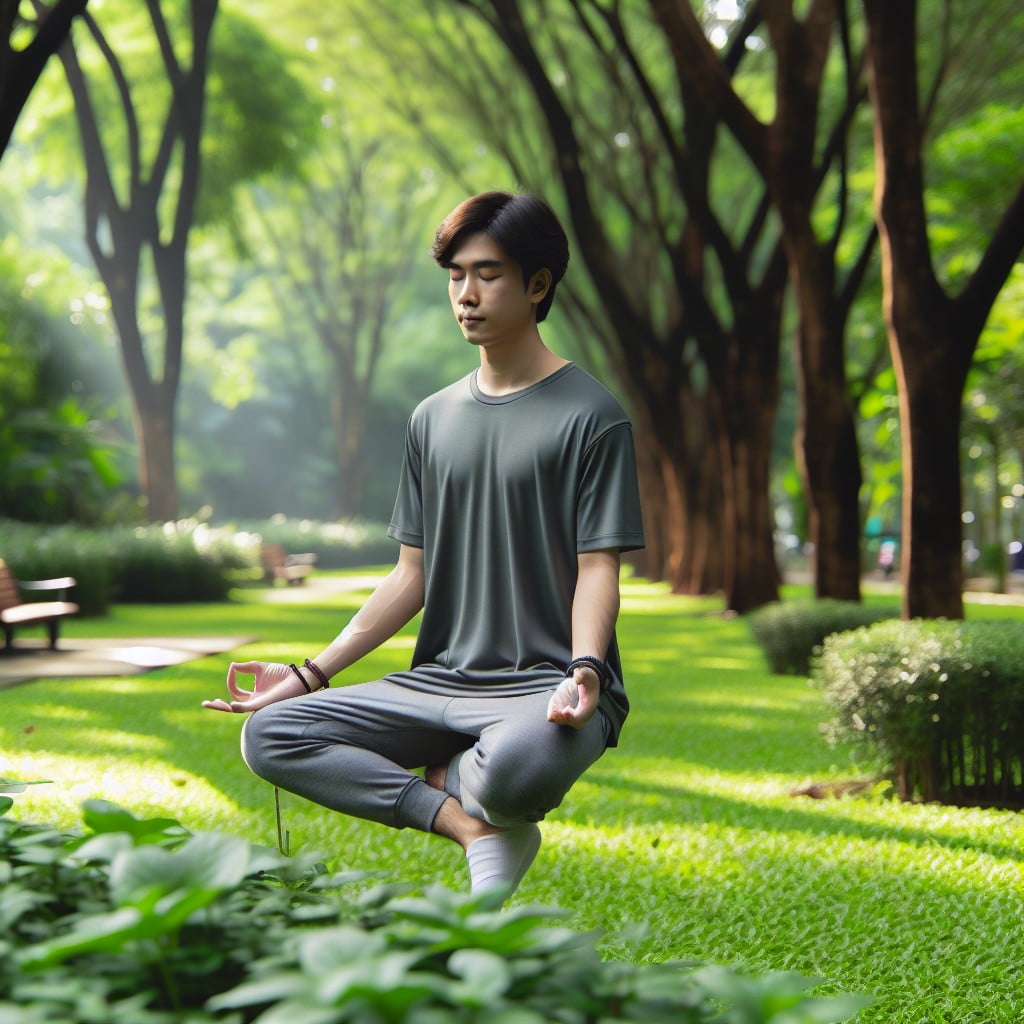Explore active meditation because bolstering mindfulness and enhancing wellbeing begins from understanding this powerful practice.
Active meditation is a dynamic approach to mindfulness that involves conscious, deliberate engagement in a task or activity. Unlike passive meditation where you aim to clear your mind, active meditation focuses on the present moment and the task at hand. This method can be particularly beneficial for those who struggle with traditional meditation techniques, offering a more accessible entry point to mindfulness.
Whether you’re walking in nature, painting a picture, or even washing dishes, active meditation encourages a state of ‘flow’, where your mind is fully absorbed in the task. As we delve deeper into this topic, we’ll explore various active meditation techniques, its benefits, and how you can incorporate it into your daily routine.
Key takeaways:
- Active meditation is a dynamic approach to mindfulness.
- It involves conscious engagement in a task or activity.
- Active meditation promotes ‘flow’ and mindfulness in the present moment.
- Techniques include mind-body synchronization, sensory involvement, movement-based activity, breathing focus, and emotion channeling.
- Consistent practice enhances mental health, reduces stress, boosts focus, and fosters self-awareness.
Understanding Active Meditation

Active meditation, unlike passive forms of meditation, requires the individual to maintain a physical role while their mind explores a particular focus or mantra.
By integrating body movements, sounds or expressive techniques, it promotes the harmony between mind and body to achieve mindfulness.
Unlike traditional passive meditation where sitting still and emptying the mind is the norm, active meditation makes use of conscious movement, often bringing the practitioner to a serene mental state.
The main idea lies in using that physical engagement to encourage mental clarity and to augment our awareness of the present moment.
Moreover, this form of meditation is ideal for people who struggle with the stillness required in the conventional methods, offering a different, yet equally beneficial approach to mindfulness and inner peace.
The Methodology Behind Active Meditation

Active meditation, otherwise known as dynamic meditation, is an immersive, body-inclusive practice based on the principle that internal serenity can be achieved through engaging the mind and body simultaneously.
1. Mind-Body Synchronization: This technique unifies physical actions with mental focus, creating a powerful interaction that fosters mindfulness.
2. Sensory Involvement: Emphasizes the importance of using all five senses. This might include attentively listening to music, feeling the texture of an object, or focusing on a pleasing scent.
3. Movement-Based Activity: Rather than serenity through stillness, active meditation employs activities such as walking, dancing, or yoga. This physical engagement helps improve concentration and ward off mind-wandering.
4. Breathing Focus: Despite being active, the importance of controlled and rhythmic breathing — a core principle of meditation — is still emphasized. This practice keeps the practitioner grounded and enhances the benefits of the meditation.
5. Emotion Channeling: Positive and negative feelings are used as tools to drive concentration, helping the practitioner remain present and fully engaged in the moment.
Getting Started With Active Meditation

To embark on the journey of active meditation, one should first cultivate an open, non-judgmental mindset. This implies acceptance of thoughts and feelings as they arise without attempting to control or suppress them.
Next, find a suitable environment for your meditation sessions. It doesn’t have to be completely quiet, but should be relatively peaceful. Ensure you’re wearing comfortable clothes and decide whether to sit, stand, or perform a movement like walking, depending on the technique you’re using.
An essential part of starting is to set an intention for the session. It could be reducing stress, improving focus, or fostering compassion. Keeping this goal in mind throughout provides a framework for the practice.
Often, a timer can be beneficial, especially for beginners, to define the meditation session’s length. Start small, with five or ten minute sessions, gradually increasing the length as your comfort level rises.
Remember that it’s okay if your mind wanders. The goal isn’t to empty your mind but to observe your thoughts without judgment. If you find yourself getting carried away, gently return your focus to your movement or breath.
Patience is key here. Don’t be discouraged if progress feels slow. The benefits of active meditation, like increased awareness and reduced stress, often take a little time to materialize clearly. Keep practicing consistently, and the results will follow.
Practical Steps for Active Meditation

To delve into the experience of active meditation, consider the following steps:
- Select a Suitable Environment: For optimal results, find a personal haven devoid of distractions. Choose a space that promotes peace and tranquility, crucial for improved focus.
- Establish a Time Limit: Especially as a beginner, start with brief periods. A five-minute stint can be gradually extended to 20 minutes or even longer.
- Begin With Physical Actions: This could be any activity that syncs your mind with the body – walking, doing yoga, or even dancing. The goal is to bring conscious attention to your movements.
- Gradual Shift to Mindfulness: Once in rhythm with your physical activity, aim to concentrate on your thoughts, fostering a mindful state.
- Observe Thoughts and Emotions: Don’t suppress any thought or emotion that surfaces. Accept them without judgment, observe, and let go.
Remember, it’s not about achieving perfection, but progress. Over time, this productive solitude fosters a deeper connection with your inner self, intensifying concentration and boosting your mental acuity.
Regular Practice: How Often to Meditate
Maintaining consistency is key in active meditation, just like any other form of mindfulness practice. So, how frequently should one meditate? Ideally, a daily routine of at least 20 minutes can establish a firm foundation. Choose a time of day that suits your schedule, whether that be in the early morning or later in the evening.
However, remember that quality trumps quantity; a shorter period of focused meditation can be more beneficial than a longer, distracted session. If 20 minutes initially feels overwhelming, start with 5 minutes and then slowly increase the time, cultivating a routine where patience meets endurance.
In times of increased stress or anxiety, extra sessions can be advantageous. These additional practices can help to cultivate a calm mind and structured thoughts, leading to better decision-making and an overall enhanced well-being.
Lastly, remember that everything in life is a process, including active meditation. Recognize that some days might be challenging, while others may feel natural. Both are integral parts of the journey towards heightened mindfulness and self-awareness.
Exploring Varieties of Active Meditation
Several forms of active meditation are key to maintaining a diverse practice. The first is Kundalini meditation, which involves rhythmic breathing and coordinated body movements to awaken the energy at the base of your spine. Next is Dynamic meditation – a vigorous technique that utilizes body movement to break down inner barriers.
Gibberish meditation, on the other hand, is a practice that involves voicing nonsensical sounds to clear the mind clutter. Another method, the Nataraj meditation, is a dance-based session designed to lose oneself in rhythms and movements, leading to a state of joyfulness and silence.
Visualization meditation is a captivating form that incorporates mental imagery or a perceived object for focus where practitioners are encouraged to explore their visual imagination for focus and clarity. Lastly, Walking meditation is a popular form of active meditation where focus is placed on the physical act of walking, the sensation of feet touching the ground, the rhythm of breathing, cultivating mindfulness, and presence in your movements.
Each technique holds unique benefits, offering various ways to engage your mind-body interaction, priming your path to heightened mindfulness.
Active Meditation for Enhancing Mental Health
Incorporating daily sessions of active meditation can contribute significantly to your mental health. Essentially, it provides a natural and effective way to reduce stress levels, improve concentration, and promote positive emotional health.
1. Stress Management: Active meditation lowers the levels of cortisol–a stress hormone–in your body. This reduction creates a sense of calm, aiding in the reduction of anxiety and creating a restorative state for your mind.
2. Boosts Focus: During active meditation, the intentional focus on a single task or thought trains your mind to be more attentive. This increased concentration transfers into everyday life, bettering your focus on tasks, even amidst distractions.
3. Fosters Emotional Health: Active meditation embraces acceptance techniques, teaching you to acknowledge your emotions without judgment. This results in a healthier emotional state, characterized by boosted self-esteem, and overall positive mental health.
4. Enhances Self-Awareness: The regular practice promotes cognitive and self-reflective processes, fostering higher self-awareness. A greater understanding of the self contributes to improved decision-making and emotional regulation.
FAQ
What is the meaning of active meditation?
Active meditation is a practice that involves dedicating one's attention to a chosen activity and being fully present in the moment, which could be as simple as going for a walk, listening to breath or paying attention to environmental stimuli.
What is the difference between active and passive meditation?
Active meditation involves maintaining a meditative state during routine activities, such as walking or eating, while passive meditation implies practicing specific meditation techniques while sitting quietly in a designated posture.
What is the difference between receptive and active meditation?
Receptive meditation emphasizes calming the mind, while active meditation employs techniques such as mantras, imagery, or visualization to stimulate a state of heightened creativity.
What are the three styles of meditation?
The three styles of meditation are mindfulness, lovingkindness, and concentration.
How does active meditation impact one's physical health?
Active meditation significantly improves physical health by reducing stress, enhancing breathing, lowering blood pressure, and promoting overall cardiovascular and immune health.
What are the primary techniques involved in practicing active meditation?
Active meditation involves techniques like mindful walking, mindful eating, performing yoga with mindful awareness, or even simple chores like washing dishes or sweeping the floor mindfully, all of which focus on keeping continuous awareness of physical sensations, thoughts, and emotions during the activity.
How to integrate active meditation into a busy lifestyle?
Integrating active meditation into a busy lifestyle can be achieved by incorporating short meditation sessions into everyday activities such as walking, eating, or even while doing housework.